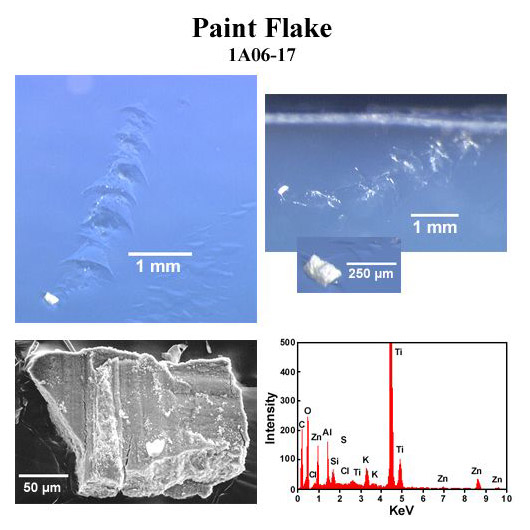Même les éclats de peintures peuvent poser problème.
(Even chips of paint can cause issues.)
Every single time we lauch into space we generate some sort of unwanted waste.
Solid-fuel rockets deposit aluminium-oxide particles.
Explosive bolts fragment into pieces.
Even chips of paint can cause issues.
In 1983 the Challenger space shuttle was struck by a 0.2mm of paint that managed to gouge this pit out of
one of its windows.
(En 1983, la navette spatiale Challenger a été heurtée par un éclat de peinture de 0,2 mm qui a réussi à
creuser un trou dans l'une de ses fenêtres.)
In fact, in the first 67 space shuttle launches, 177 impacts were found in the windows. 45 of which were
large enough to warrant a replacement window.
Post-mission analysis determined all of these impacts we caused by space debris, with 44% being caused by
aluminium alloys, 37% by paint chips, 12% by steel, 5% by Cooper and 2% by titanium.
At 50.000 $ a pop, this did not come cheap.
Based on these numbers, the space shuttle had 67% chance of impact causing significant damage to the windows
during their 10 day missions, and these probabilities have only risen over time.
In 2007 the likelihood of a collision between any satellite in LEO and a piece of debris over 1 centimeter
in size was 17-20% in a single year.
That statistics increased to 25-33% later that year when China tested their own anti-satellite missile.
By 2010 the chance of a 1 centimeter piece of debris striking a satellite had increased to 50% a year, after
two full-sized satellites Iridium 33 (US communication satellite) and Kosmos 2251 (a retired Russian
communications satellite) collided at 42.000 km per hour. Obliterating both satellites and producing over
1000 fragments over 10 centimeters in size and many more too small to be tracked.
Voir la vidéo Whipple Shield dans 1_debris : Une balle en aluminium de 2,8 mm de diamètre se déplaçant à 7
km / s perce un blindage candidat pour un vaisseau spatial, capturé par une caméra à grande vitesse à
l'Institut Fraunhofer pour la dynamique à grande vitesse en Allemagne. src
: https://www.esa.int/ESA_Multimedia/Videos/2018/02/Hypervelocity_impact_testing/(lang)
Src : The truth about space debris
https://www.youtube.com/watch?v=itdYS9XF4a0&ab_channel=RealEngineering
